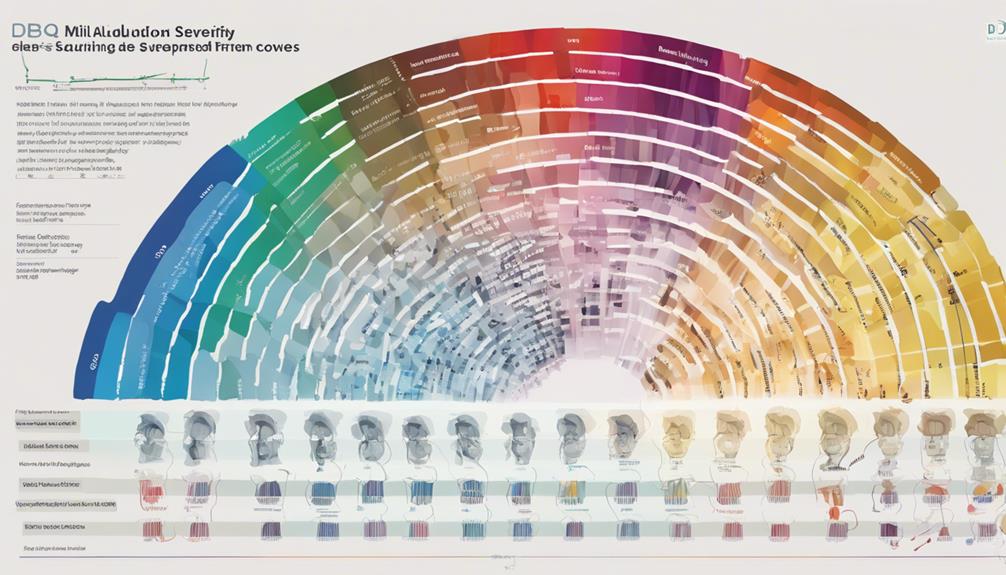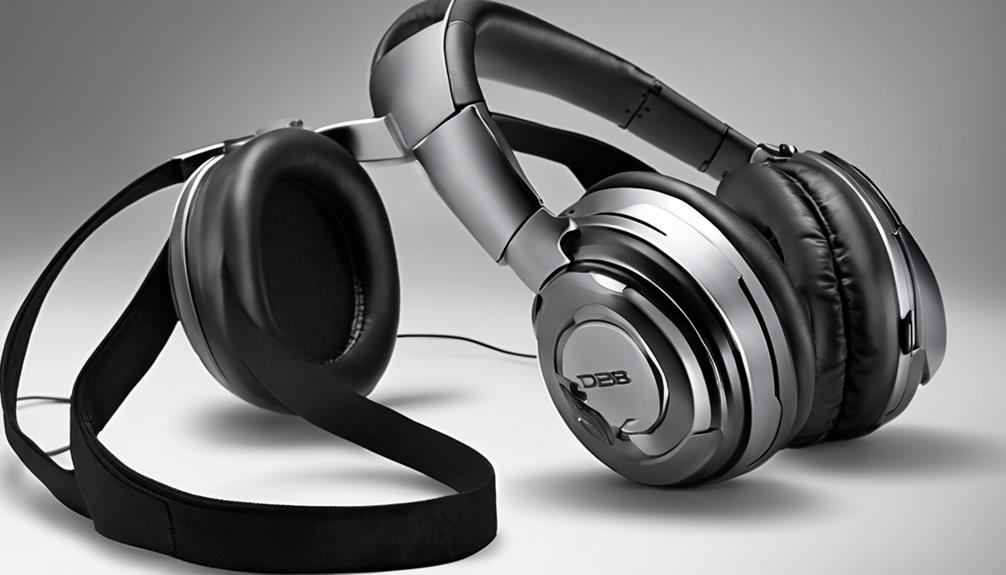In the intricate realm of assessing hearing loss and tinnitus, the DBQ Audio Form serves as a crucial tool, shedding light on essential factors necessary for VA disability claims.
As we navigate the complexities of distinguishing between these conditions and understanding the evaluation criteria, one cannot help but ponder the depth of insight this form provides.
But what lies beneath the surface of this document, and how does it truly impact the lives of those seeking support?
Join us as we unravel the layers of the DBQ Audio Form to uncover its significance in the realm of hearing health and disability evaluations.
Key Takeaways
- Streamlines VA Disability claims evaluation process with comprehensive audiologic measurements.
- Determines severity of hearing loss through detailed audiometric testing.
- Documents Tinnitus symptoms, impact, treatments, and changes over time.
- Assesses daily life impact, communication difficulties, and emotional toll of Hearing Loss and Tinnitus.
DBQ Audio Form Overview
The DBQ Audio Form streamlines the evaluation process for Hearing Loss and Tinnitus in VA Disability claims by providing a comprehensive framework for assessing symptoms and audiologic measurements. This form is a vital tool in gathering detailed information about the history and symptoms related to Hearing Loss and Tinnitus.
It includes specific sections dedicated to evaluating speech discrimination, puretone thresholds, and other essential audiologic measurements crucial for determining VA disability ratings. Completed by audiologists, the DBQ Audio Form ensures a thorough evaluation of Hearing Loss and Tinnitus, allowing for an accurate assessment of the impact on an individual's hearing health.
Evaluation of Hearing Loss Severity

Evaluating the severity of hearing loss involves conducting detailed audiometric testing to assess the extent of impairment and its impact on daily life. This process includes measuring puretone thresholds through air and bone conduction to determine the level of hearing impairment accurately.
Speech discrimination testing is also crucial in evaluating hearing loss severity as it assesses the individual's ability to understand speech, especially in noisy environments. The audiologist will carefully document the results of the evaluation, which typically includes the speech discrimination percentage and the puretone threshold average.
Documentation of Tinnitus Symptoms
Having thoroughly evaluated the severity of hearing loss, we now shift our focus to documenting the symptoms of Tinnitus experienced by individuals undergoing audiometric testing. Tinnitus symptoms documented in the DBQ Audio form include the frequency and severity of ringing, buzzing, or other noises in the ears. The form also assesses the impact of Tinnitus on daily activities, sleep quality, and overall quality of life. Additionally, information regarding any treatments or medications used for managing Tinnitus is included in the form. The audiologist conducting the evaluation reviews the history of Tinnitus, its onset, and any changes over time to provide a comprehensive assessment.
| Aspect | Details |
|---|---|
| Frequency | How often Tinnitus symptoms occur |
| Severity | Intensity or loudness of the Tinnitus sounds |
| Impact | Effects on daily activities and quality of sleep |
| Treatments | Medications or therapies used for Tinnitus management |
| Medications | Specific drugs prescribed for Tinnitus relief |
Impact on Daily Life Assessment

Assessing the impact of Hearing Loss and Tinnitus on daily life activities provides crucial insights into the challenges individuals face in communication, work environments, and social interactions. The DBQ Audio Form delves into the following aspects:
- Communication Difficulties: It evaluates how Hearing Loss and Tinnitus affect the ability to hear conversations, understand speech, and engage in group settings.
- Environmental Sounds: The form considers the impact on hearing essential sounds like alarms, warnings, and other environmental cues.
- Quality of Life: It assesses how these conditions influence the overall quality of life, including daily experiences and interactions.
- Mental Health: The form evaluates the effects on mental well-being, highlighting the emotional toll of struggling with Hearing Loss and Tinnitus in noisy environments.
Importance in VA Disability Claims
The significance of the DBQ Audio form in VA Disability Claims lies in its comprehensive evaluation of hearing loss and tinnitus, aiding in determining appropriate compensation for veterans. By detailing speech discrimination, puretone thresholds, and overall auditory function, this form plays a crucial role in assessing the impact of hearing-related conditions on individuals. The table below highlights how the DBQ Audio form influences VA disability claims by documenting audiometric test results and clinical findings, which directly impact the VA disability rating and subsequent compensation for veterans.
| Aspect of Evaluation | Impact on VA Disability Claims |
|---|---|
| Speech Discrimination | Determines communication challenges and functional limitations. |
| Puretone Thresholds | Indicates the severity of hearing loss and need for compensation. |
| Audiometric Test Results | Provides objective data for assessing the extent of hearing impairment. |
Completing the DBQ Audio form accurately is essential for expediting the claims process and ensuring that veterans receive the appropriate support for their hearing impairments.
Frequently Asked Questions
Is There a Dbq for Tinnitus?
Yes, there's a Disability Benefits Questionnaire (DBQ) specifically for Tinnitus, aiding the VA in evaluating and rating its severity. This document covers key details like symptom onset, frequency, impact on daily life, and any related factors such as hearing loss.
VA examiners rely on the Tinnitus DBQ to assess the overall impact on veterans' well-being. Accuracy in completing this form can significantly influence VA rating decisions for Tinnitus claims.
What Does the VA Pay for Hearing Loss and Tinnitus?
When it comes to compensation for hearing loss and tinnitus, the VA offers varying levels of financial support based on the severity of the condition. Hearing loss compensation ranges from 0% to 100%, while tinnitus is set at a flat rate of 10%.
These payments are tailored to individual cases and ratings. The VA's aim is to provide veterans with the necessary financial assistance to cope with the challenges posed by these conditions.
What Do I Write in My VA Tinnitus Claim?
When writing our VA tinnitus claim, we should include details about when the tinnitus started, how it affects our daily life, any incidents during service that may have contributed to it, and any medical treatments sought.
Describing the impact on our ability to concentrate, sleep, and communicate is crucial to convey the overall effect on our quality of life.
These elements provide a comprehensive picture for our claim.
What Is the Maximum VA Rating for Hearing Loss and Tinnitus?
We can help clarify the maximum VA ratings for hearing loss and tinnitus. Hearing Loss has a top rating of 100%, while Tinnitus maxes out at 10%. These ratings reflect the severity and impact of each condition on daily life.
VA rates Hearing Loss under DC 6100 and Tinnitus under DC 6260 in the Schedule for Rating Disabilities. It's important to understand the distinct criteria and limitations for each condition when seeking VA benefits.
Conclusion
In conclusion, the DBQ Audio Form provides a comprehensive assessment of hearing loss and tinnitus for VA disability claims.
By evaluating the severity of hearing loss, documenting tinnitus symptoms, and assessing the impact on daily life, this form plays a crucial role in determining eligibility for benefits.
Like a symphony conductor orchestrating a complex performance, the DBQ Audio Form harmonizes the data needed for accurate disability evaluations.











